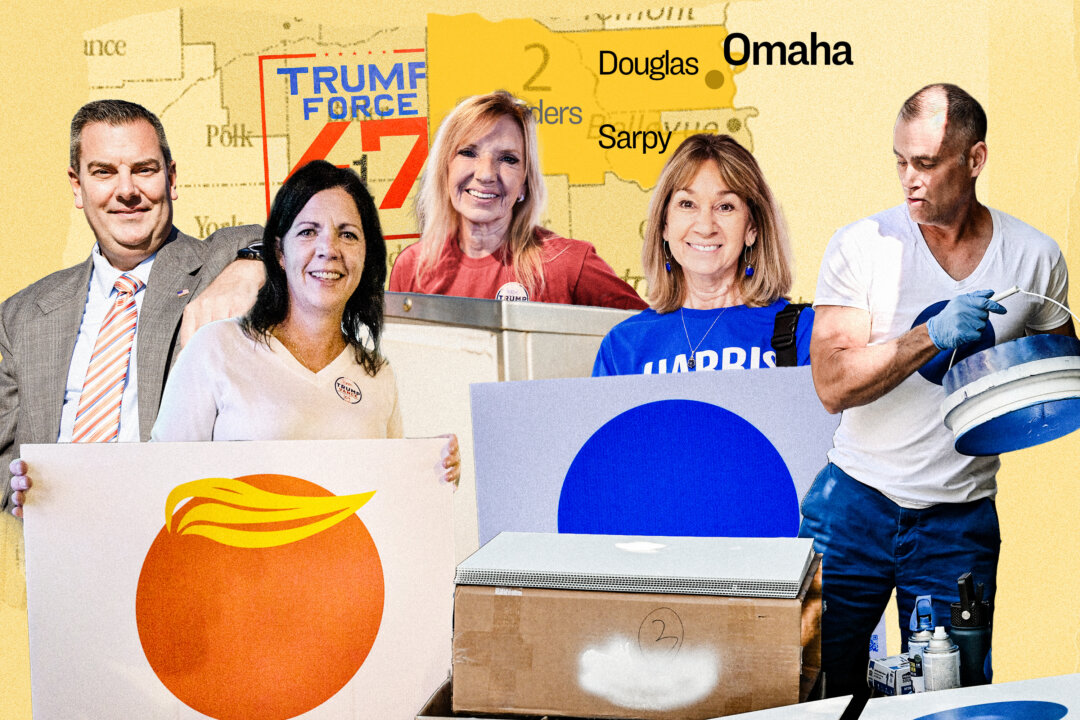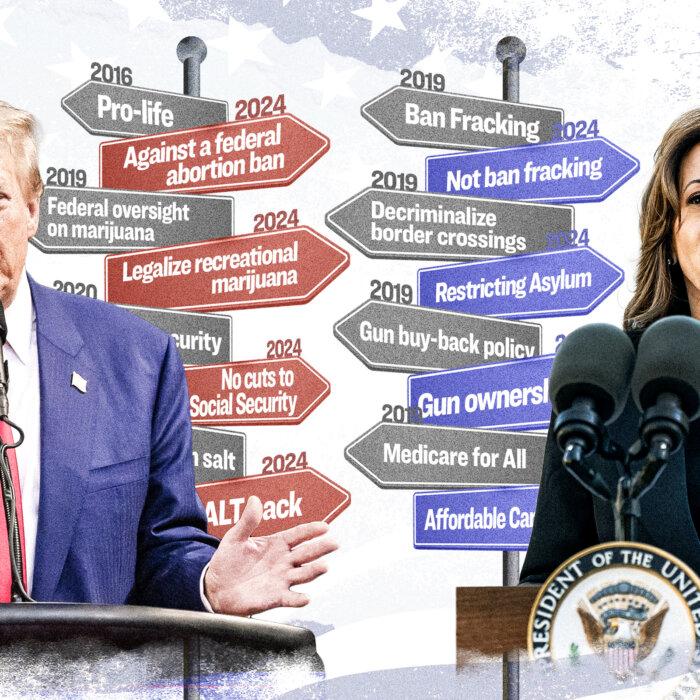OMAHA, Neb.—In the three-county area comprising Nebraska’s 2nd Congressional District, election officials, local party leaders, and voters agree on one thing: winning the district will be purely a matter of turnout.
Nebraska is one of two states that splits its votes in the Electoral College. This presents a rare opportunity for partisans to seize an extra vote in the presidential contest. A single electoral vote can be critical if the race is close.
In the district, Democrats are working to peel off a vote for their candidate while Republicans are trying to keep the most populous part of the conservative Cornhusker State in the fold for the GOP.
Voter registration data and local history suggest there is a narrow margin between turning the jurisdiction—centered on Omaha—blue or keeping it red.
Those who spoke with The Epoch Times said the final days of the election season in the Omaha metro area will be dedicated to get-out-the-vote efforts. Both sides believe rallying their base can lead to victory in both the 2nd Congressional District and possibly the entire Electoral College.
“Everybody needs to get out to vote,” Amy O’Connor, a Democratic voter from Douglas County, Nebraska, told The Epoch Times. “We need to work ’til the very end.”
The 2nd Congressional District
In 1992, the Cornhusker State converted from a winner-take-all system to one that apportions two of its five electoral votes to the state’s popular vote winner. The remaining votes go to the popular vote winner in each of its three congressional districts. The system with its multiple popular vote contests can lead to a split electoral vote.
Twice, in 2008 and 2020, the district voted for the Democratic Party’s presidential candidate. In both instances, the Democrat won the White House.
The district includes the entirety of Douglas County, the most populous area in the state, half of Sarpy County, Nebraska’s third-most populous county, and all of rural Saunders County. About 30 percent of Nebraskans—586,330 people—live within the borders of Douglas County, according to data published by the Omaha-based regional interest coalition, the Metropolitan Area Planning Agency.
Demographic research conducted by the University of Nebraska at Omaha in 2022 determined that the county’s population is predominantly white, well-educated, and earning more than the national median household income.
Politically, Douglas County is closely divided between the two major parties. In an interview with The Epoch Times, Douglas County Election Commissioner Brian Kruse said there were about 362,000 registered voters in the county at the end of September. About 133,000 are registered as Democrats, about 128,000 as Republicans, and about 92,000 as nonpartisan. Fewer than 10,000 are members of other political parties.

Kruse said the November ballot is exceptionally busy in the state. Along with the presidential race, Nebraska voters will consider district races for the House and its two Senate seats, as well as a number of initiatives on hot-button issues such as abortion access and the legalization of medical marijuana.
Typically, about 70 percent of registered voters vote, Kruse said. He expects around 75 percent of Douglas County voters to cast a ballot.
Democrat Strategy

Polling consistently shows Harris holding an advantage in the district. The latest survey, published by The New York Times and Siena College on Sept. 28, found that 51 percent of likely voters say they will vote for the Democratic presidential candidate.
CJ King, chair of the Douglas County Democratic Party, said he believes questions about abortion on Nebraska’s ballot could boost overall turnout for the Democrats in the district. He pointed to victories for similar measures in conservative Kentucky and Kansas in recent elections.
King said he knows many voters consider the economy and finances as top election issues. He said the pandemic year of 2020, when President Donald Trump was in office, was “not the best year of my life.” Under Biden, he says, the economy is “generally good,” citing job demand and infrastructure investment.
O’Connor, a former Omaha school teacher who has volunteered for Democratic causes during this election cycle, said Nebraska’s split voting in the Electoral College brings millions of dollars to the local economy every four years and attracts national candidates to the city.

In September, Nebraska Gov. Jim Pillen said he might call a special session of the Nebraska Legislature to consider a proposal to revert the split electoral voting in 2024 to winner take all. The effort was stymied by a lack of support. O’Connor called the GOP-led scheme “very sneaky.”
On Sept. 27, political spending tracking firm AdImpact said more than $10 million had been spent on advertising related to the presidential race in the district. As of Sept. 27, all of the presidential race ad spending in the final eight weeks of the race was booked by Democratic groups.
Representatives of the Harris campaign in Omaha did not respond to a request for comment from The Epoch Times.
Some electoral college scenarios show the presidential contest coming down to a single electoral vote. Both King and O’Connor said they hope that doesn’t happen. But King said it’s his job to send the 2nd Congressional District’s vote to Harris.
“We’re just going to outwork them,” King said. “We’re just going to get people excited about it.”
Working to Keep Omaha Red
Despite the district’s two famous departures to Democrats, the 2nd Congressional District has voted with Nebraska’s Republican majority in six out of the eight presidential elections held since 1992.
Michael Tiedeman, chairman of the Sarpy County Republican Party, told The Epoch Times that Douglas County’s southern neighbor is predominantly Republican.
About 126,000 registered voters reside in the county, according to Tiedeman. About 56,000 are registered as Republicans, about 34,000 as Democrats, and another 34,000 as independents. The county is split between Nebraska’s 1st and 2nd Congressional Districts, with the 1st District being more populated.
Republican voters are motivated by their concern about the economy and the high rate of inflation impacting the cost of living in the Omaha metro area, Tiedeman said. Conservatives are also bothered by what he called an “open border,” hastening the arrival of illegal immigrants into Nebraska.



Without big spending at their backs, local Republicans are focusing on grassroots efforts to maintain the GOP’s perennial advantage in the area.
To that end, the Republican National Committee and the Trump campaign are turning to a joint venture called Trump Force 47. The effort is dedicated to recruiting local Republicans and deploying them to get out the vote in their communities.
Maggie Bellino-Bunde, a Trump Force 47 volunteer from Douglas County, told The Epoch Times the initiative is working on identifying low-propensity Republican voters—people who may not participate in every election—and going to their homes to try to get them to commit to voting either in person or by mail.
Malia Shirley, the executive director of the Nebraska Freedom Coalition, told The Epoch Times the division between how national Democratic and Republican interests are addressing the race is typical for the region. Democrats spend big to saturate the airwaves with advertising, while Republicans pound the pavement, she said.
“[Democrats] don’t necessarily have a super strong ground game,” Shirley said.

The Nebraska Freedom Coalition is a political action committee founded in 2021. Shirley said the PAC is focused on supporting conservative candidates.
Like the Democrats The Epoch Times interviewed, Teiedeman said he thinks winning or losing in November will come down to voter turnout. In 2020, Sarpy County saw a 75 percent turnout. He would like to see it grow to 80 percent in 2024.
Shirley said getting conservative voters to the polls will likely come down to canvassing and making connections with local voters.
“Doors win wars,” Shirley said.
Certain issues are overwhelmingly important to busy voters, she said. Finding out what those issues are, “and letting them know why our candidates can deliver that for them is the key to victory.”
The Battle of the Dots
Across the contested district, Democrats are rallying around a simple image: a blue circle on a white field.
The so-called blue dot adorns homemade and mass-produced campaign signs around Omaha and its environs. At a watch party for the vice presidential debate between Sen. JD Vance (R-Ohio) and Minnesota Gov. Tim Walz, hosted by the Douglas County Democratic Party, the room was adorned with white pumpkins painted with the local Democratic symbol.
King said the blue dot is a sign of “renewed energy” for local Democrats in a region dominated by conservative politics. King said the idea originated in 2008 when the 2nd Congressional District was lit up blue on national Electoral College maps.



“We’ve got a chance to do this again,” King said of the possibility of delivering an electoral vote to Democratic nominee Vice President Kamala Harris.
Tiedeman said the campaign is creative, but, “We can both play that game.”
Local Republicans are now putting up their own signs—portraying a red dot sporting Trump’s trademark coiffure.






